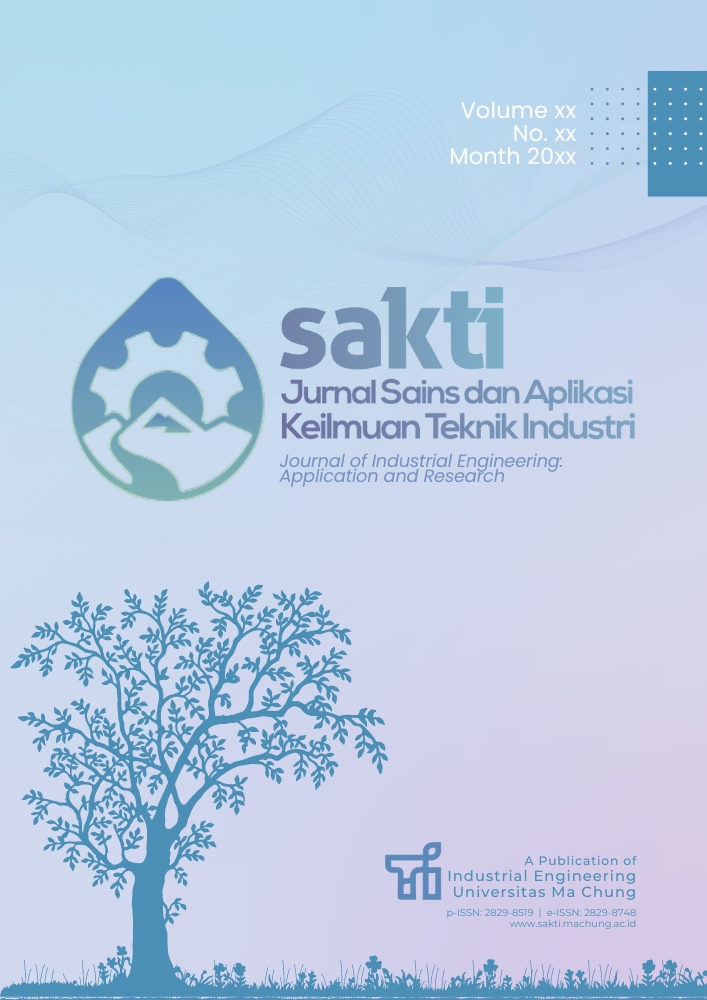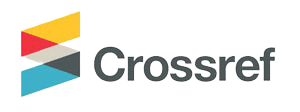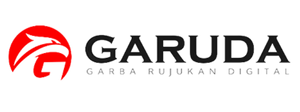| GENERAL |
| Editorial Board |
| Focus and Scope |
| AUTHOR LINK |
| Online Submission |
| Publication Policy |
| Author Guidelines |
| Download the Template |
| REVIEWER LINK |
| Become a Reviewer |
| Reviewer Guidelines |
| List of Reviewers |
| ISSN |
| p-ISSN : 2829-8519 |
| e-ISSN : 2829-8748 |
| CALL FOR PAPERS |
| Vol.04, No.01, June 2024 |
 |
| SAKTI by |
 |
| SAKTI is indexed in |
 |
 |
 |
 |
| TOOL(S) |
 |
Author Guidelines
Article Template
In order to ensure that your manuscript is prepared correctly and ready for submission, it is important to submit it for review. To help you meet the necessary publication standards, we ask that you utilize our submission template (DOCX). This template has been specifically designed to provide clear formatting instructions and guidelines for authors, allowing you to seamlessly integrate your own sentences within the pre-existing template.
One key aspect to keep in mind when submitting your manuscript is that it will undergo a double-blind review process. This means that the identities of the authors will be concealed from the reviewers, and vice versa. To facilitate this process, it is essential that the submitted file does not include any author information. This includes the names, affiliations, and contact details of the authors.
After the blind-review process, author information will be added to the manuscript. This information will be used to provide proper credit to the authors and to facilitate communication with them during the publication process. By following these guidelines, you can help ensure that your manuscript is reviewed fairly and that the publication process proceeds smoothly.
Ethics in Publishing
As an ethical publisher, we take research integrity seriously and require all authors who submit papers to our journal to agree to the SAKTI Ethics Statement for Authors (the statement can be found on the submission checklist). This statement covers critical ethical considerations such as authorship, originality, and conflicts of interest. It is crucial for authors to read and comply with this statement when submitting their manuscripts to ensure their work adheres to the highest standards of research integrity.
To verify the originality of your manuscript, we may use Turnitin, an originality detection service. This service compares your manuscript to an extensive database of published works and other materials available on the internet to identify instances of plagiarism or other forms of unoriginal content. This helps us to ensure that all manuscripts we publish are original and have not been previously published elsewhere. If authors choose to use other plagiarism checking applications, they are welcome to do so. However, we do require that authors send the results of the plagiarism check along with their article when submitting to our publication.
It's important to note that the allowed Turnitin check is a maximum of 25%. This means that your manuscript should have a similarity index of no more than 25%. Any similarities identified by Turnitin that exceed this percentage may require further investigation, and the publisher may request revisions or reject the manuscript if necessary.
We understand that the process of submitting an article for publication can be complex, and we are committed to making it as straightforward as possible. By accepting the SAKTI Ethics Statement for Authors and complying with its requirements, as well as submitting your manuscript for originality checking through Turnitin, authors can help ensure the integrity and credibility of their research, as well as our journal. We appreciate your cooperation in upholding these important standards.
Changes to Authorship
As an author, you may find it necessary to make changes to the list of authors on your accepted paper. If you wish to add, delete, or rearrange authors, please note that the process may differ depending on whether your paper has been published online or not.
If your paper has not yet been published online, the corresponding author should contact the Journals Manager and provide a written request that includes the reason for the change, as well as the written consent of all co-authors, including those being added or removed. A form template is provided to help facilitate this process. The paper will not be published until all changes have been agreed upon.
In the case of online publication, any requests to add, delete, or rearrange author names will follow the same policies as noted above. However, changes made after online publication will result in a corrigendum being issued to correct the author list.
We take authorship seriously and strive to ensure that all authors receive proper credit for their work. It is important that any changes made to the author list are agreed upon by all co-authors to maintain the integrity of the publication. Thank you for your cooperation in helping us uphold these standards.
Copyright
As an author whose paper has been selected for publication, you will be required to sign our copyright assignment form. This form assigns copyright ownership of your work to the publisher, allowing us to legally publish and distribute your paper.
In addition, it is important to ensure that any material used in your paper that is protected by copyright has been properly attributed and used with permission. If you have included any copyrighted material, such as images, figures, or text, in your paper, you must obtain permission to use this material and provide proper citation.
Obtaining permission to use copyrighted material can involve contacting the copyright owner directly, submitting a request through a copyright clearance service, or using material that is licensed under Creative Commons or other similar licenses. It is the responsibility of the author to obtain permission and provide proper attribution for any copyrighted material used in their paper.
By following these copyright guidelines, you can help ensure that your work is published legally and ethically. We appreciate your cooperation in upholding these important standards.
Author Rights
As an author, you may be interested in reusing your own work for various purposes, such as including it in a book or using it in a presentation. To learn about your rights to reuse your work, we recommend referring to our Publication Ethics and Policy page.
Our Publication Ethics and Policy page outlines important information about author rights, including copyright ownership and licensing. It also provides guidance on how authors can properly reuse and share their own work, while still respecting the rights of others.
By referring to our Publication Ethics and Policy page, you can ensure that you are following the appropriate guidelines for reusing your work. We encourage authors to take advantage of their rights to reuse their own work, while also respecting the intellectual property rights of others.
Thank you for considering these important ethical considerations when using and sharing your work.
Role of the Funding Source
As an author submitting an article, it is important to identify any sources of financial support that were used in the conduct of the research and preparation of the article. Additionally, authors should briefly describe the role of any sponsor(s) in the study design, data collection, analysis and interpretation, writing of the report, and decision to submit the article for publication.
If the funding source(s) had no involvement in any of these areas, it should be clearly stated. This information is necessary for transparency and to ensure that any potential conflicts of interest are disclosed to readers.
By disclosing any financial support and the role of any sponsor(s), readers can better understand the context of the research and potential influences on the findings and conclusions. This information also helps to ensure the integrity of the research and the publication process.
Thank you for your attention to this important aspect of the submission process.
Publishing Policy
If your paper is accepted for publication, you will be able to access and download the published article online on the website.
Language
As part of the submission process, it is important to ensure that your paper is in good grammatical condition in English. If your paper is not easily understandable, it may be rejected.
In addition to the main text, it is also important to include an acknowledgment section. This section should list any individuals who provided help during the research, as well as any grants received from institutions. Please provide detail grants number and year for each grant received.
When including references, it is important to use accessible sources and ensure that all work cited in the text is included in the reference list. The dates and authors given in the text must match those in the reference list, and references should always be given in sufficient detail for the reader to locate the work cited.
To ensure consistency and accuracy in your reference list, we recommend following the appropriate format for your field of study. By properly citing your sources and providing sufficient detail, you can ensure that your research is accurately represented and easily understood by readers.
Thank you for your attention to these important details in the submission process.
Nomenclature and Units
Please ensure that the terminology and notation used are clear and easily understandable. Spell out all abbreviations and acronyms in full when they are first mentioned in the text.
For the measurement units, it is strongly recommended to use SI units. However, if non-SI units are necessary, please provide their SI equivalents or conversion factors. Use the spellings 'litre' and 'metre', and not 'meter' (which refers to a measuring instrument), when writing in English.
In English manuscripts, use a decimal point instead of a comma for numbers (e.g., 1.234 instead of 1,234).
Equations should be written in metric units or in dimensionless form. Use italic letters to denote variables in both the text and displayed equations.
Artwork
Ensure that all figures are correctly inserted and positioned in your Word files, and also provide separate graphics files in their original formats, preferably in EPS, TIFF, or PSD formats with a minimum of 300 dpi. Figures should be numbered sequentially and placed near the first citation in the text. Each figure must have a caption that describes the illustration and can be understood independently of the main text. The caption should be provided in the text, not on the figure itself.
To avoid any issues during production, use scale bars instead of magnification factors since figures may be resized.
Tables
When submitting an article, it is important to present tables in editable text rather than as images. Tables should be numbered sequentially based on their appearance in the text and any notes should be positioned underneath the table. While tables can be a useful tool, it is important to limit their use and ensure that the data they contain does not duplicate information presented elsewhere in the article. To ensure that the text area can accommodate both figures and tables, it is important to verify their size beforehand. It is recommended to avoid using vertical lines in tables.
References
The referencing and citation style used by SAKTI is APA 6th style, and authors may utilize different software to make the process easier.
Citations in text
- Use surname of author and year of publication: Jones (2002) or (Jones, 2002).
- Insert initials only if there are two different authors with the same surname and same year of publication.
- Two or more years in parentheses following an author's name are cited in ascending order of year, and two or more references published in the same year by the same author are differentiated by letters a, b, c, etc. For example: Brown (1999, 2002, 2003a, 2003b).
- Only two authors can be cited as Booth and Reinelt (1993) or (Booth &Reinelt, 1993).
- The abbreviation "et al." should be used in the text when there are more than two co-authors of a cited paper. For example: Hwang, S.A., Hwang, S.J., Park, S.R., Lee, S.W., 2016, can be written as Hwang et al. (2016) or (Hwang et al., 2016).
- Different references cited together should be in date order, for example: (Smith, 1959; Thomson & Jones, 2008; Green et al., 2015).
If a paper has been accepted for publication but has not been published the term "(in press)" should be used instead of a date. - Please ensure accuracy by verifying that each reference cited in the text corresponds to an entry in the reference list and vice versa.
Reference Links
In order to link references to the source material, we utilize digital object identifiers (DOIs). For this to be possible, it is essential that the data provided in the references are accurate. It is crucial to exercise great care, particularly when copying references, to verify that surnames, journal or book titles, publication year, and pagination are all accurate. Additionally, if DOIs are available, please include them.
List of References
At the conclusion of the manuscript, a list of references should be presented in alphabetical order. While it is recommended to use "et al." in the body of the text, all authors' names must be included in the reference list.
Journal reference style:
Berawi, M.A., 2017. Stimulating Innovation and Creativity: The Way Forward. International Journal of Technology, Volume 8(1), pp. 1-4
Zeng, R.J., Lemaire, R., Yuan, Z., Keller, J., 2004. A Novel Wastewater Treatment Process: Simultaneous Nitrification, Denitrification and Phosphorus Removal. Water Science and Technology, Volume 50(10), pp. 163-170
Book reference styles - (i) article in compilation; (ii) multi-author work; (iii) standard reference; (iv) report; (v) thesis:
(i) Cheng, J.J., 2010. Biological Process for Ethanol Production. In: Biomass in Renewable Energy Processes, Cheng, J.J., (ed.), CRC Press, Taylor & Francis Group, Boca Raton, Florida, USA, pp. 211-233
(ii) Lampman, G.M., Pavia, D.L., Kriz, G.S., Vyvyan, J.R., 2010. Introduction to Spectroscopy. 4th Edition. USA: Brooks/Cole
(iii) United States Environmental Protection Agency (US EPA), 1991. Health and Environmental Effect Document for Methylcyclohexane. Office of Health and Environmental Assessment, Cincinnati, OH, USA
(iv) Sobsey, M.D., Pfaender, F.K., 2002. Evaluation of the H2S Method for Detection of Fecal Contamination of Drinking Water. Report WHO/SDE/WSH/02.08, Water Sanitation and Health Programme, WHO, Geneva, Switzerland
(v) Taa, P.D.S., 2010. Effects of Installation of Group Pile due to Slab Uplift of Nailed-slab Resting on Expansive Subgrade. Master’s Thesis, Graduate Program, Universitas Gadjah Mada, Yogyakarta, Indonesia
Online references
It is recommended that the citation includes the complete URL and the date of access. It is important to double-check that the cited work is still available.
BASIN (Boulder Area Sustainability Information Network), 2005. Current Theme: Watershed. National Sanitation Foundation Water Quality Index. Available online at http://bcn.boulder.co.us/basin/watershed/wqi_nsf.html, Accessed on December 25, 2015
SUBMISSION CHECKLIST
Prior to submitting an article for review to the journal, it is recommended to refer to the following checklist for final verification. For more information on any item listed, please refer to the Instruction for Authors.
Ensure that the following items are present
One author has been designated as the corresponding author with contact details:
- E-mail address
- Full postal address
All necessary files have been uploaded, and contain:
- Keywords
- All figure captions
- All tables (including title, description, footnotes)
Further considerations
- The manuscript has undergone thorough spell-checking and grammar-checking, ensuring that it meets the high language standards set by SAKTI.
- References have been meticulously formatted according to the journal's specific guidelines.
- Every reference listed in the Reference section is appropriately cited in the manuscript, and vice versa. This meticulous attention to detail ensures that readers can easily locate the source material referenced in the manuscript.
- Authors are reminded that permission must be obtained for the use of copyrighted material from external sources, including the internet. This requirement is critical to maintaining the integrity of the manuscript and the reputation of the journal. It is the responsibility of the authors to obtain such permission and provide evidence of it during the submission process. Failure to do so may result in rejection of the manuscript or legal action against the authors.
AFTER ACCEPTANCE
Use of the Digital Object Identifier
The use of a Digital Object Identifier (DOI) is an important tool for authors to ensure that their research is easily accessible and properly cited. The DOI is a unique identifier that is assigned to each paper when the first proof is generated. It provides a permanent link to the paper, ensuring that it can be easily cited and located by other researchers.
Proofs and Copyright
Once the paper has been accepted and published, authors will receive a proof of the paper by email. This proof should be carefully checked for any typesetting errors or other mistakes, and any necessary corrections should be returned within one week of receipt. The authors are responsible for proofreading and ensuring that their paper is free from errors.
Offprints
Once the paper has been published online, it can be freely accessed and downloaded from the journal's website. If an author prefers a printed copy of their paper, they can request offprints from the journal manager. Pricing information can be obtained by contacting the manager directly.
AUTHOR INQUIRIES
For further advice please contact:
E-mail : sakti@machung.ac.id or teguh.oktiarso@machung.ac.id

